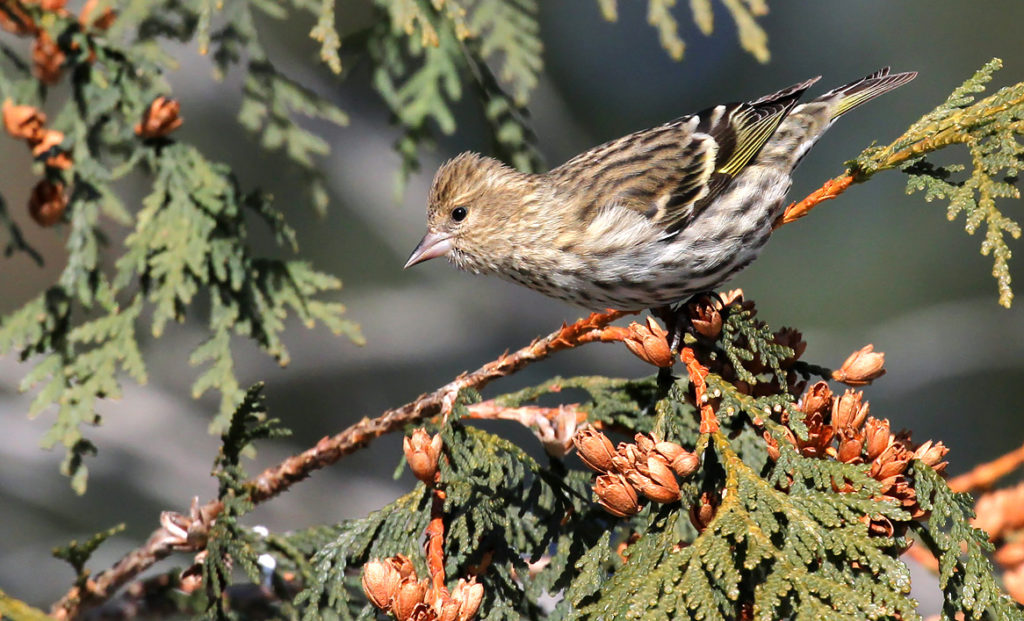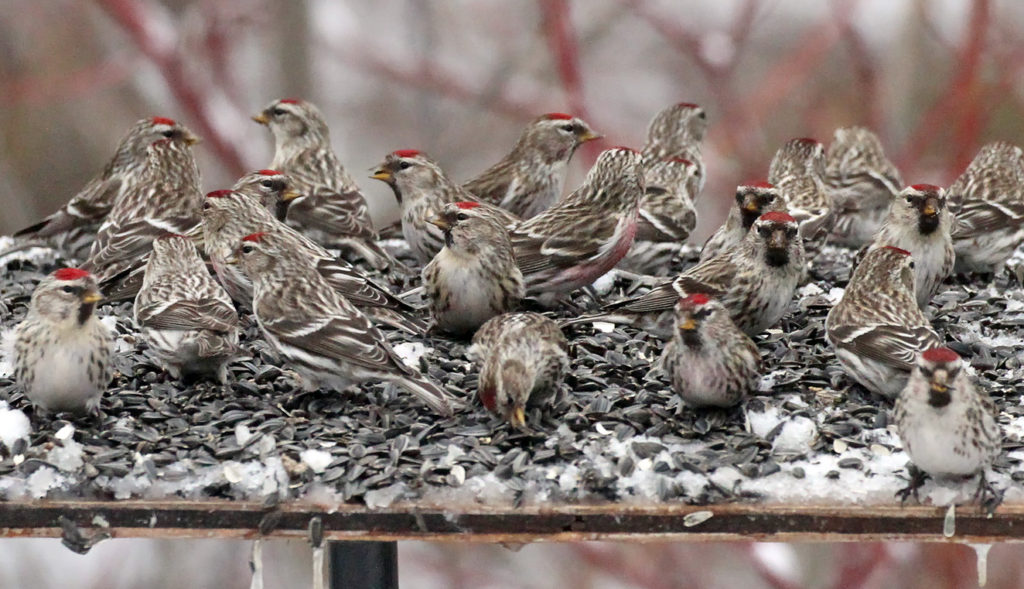
Back-to-Back: Western Great Lakes Host Bounty of Winter Finches for Second Straight Year:
by Ryan Brady
After an extremely poor showing in 2019-20, winter finches invaded the western Great Lakes region in 2020-21, a flight that will be remembered most for the best influx of Evening Grosbeaks in many years. As summer days transitioned to fall, birders began to ponder what this year’s finch season would look like, and frankly, the picture was unclear. Severe drought impacted many areas, fires blazed to the north and west, and fruit and seed crops were a mixed bag at best. Tyler Hoar’s Winter Finch Forecast indicated this region, especially near Lake Superior, was one of uncertainty given the weather wild cards in play and resulting variation in food sources across the region. Was another year of finch fun about to unfold, or would the winter doldrums return?
Answers came quickly as Common Redpolls were spotted in several states in late September and early October, nearly a month earlier than usual. Pine Siskins moved in numbers by mid-October. White-winged Crossbills arrived in earnest around the same time, seemingly from the north and east, and poured widely into the region throughout early November. Redpolls flooded south by the thousands around then as well, quickly reaching relatively southern latitudes. Less dramatically but no less impressively, Pine Grosbeaks made a steady push to southern reaches of the north woods in November and December, a pattern echoed to some extent by a favorite “honorary winter finch” for many, the Bohemian Waxwing.
So where does that leave us today? Let’s take a look at the status of each species across the region this month.
Common and Hoary Redpolls
Common Redpoll is the most widespread and abundant of the winter finches this year, occurring in numbers across most of Minnesota, Wisconsin, and Michigan and extending to Kansas City, St. Louis, and Indianapolis. Among them are decent numbers of Hoary Redpolls as far south as Chicago.

Look for both species in birches, alders, tamaracks, cedars, and weedy fields. As winter rolls on and these food sources get depleted, increasing numbers will visit feeders, where they prefer nyjer and sunflower seeds.

White-winged and Red Crossbills
Second to redpolls, White-winged Crossbills are the story of the season. Excellent numbers can be found widely across the region, including unusually far south in Minnesota and Wisconsin. Birders across Iowa, Illinois, and Indiana should be on the lookout at small-coned conifers such as spruces, hemlocks, and tamarack, and even wayward individuals at feeders are not out of the question. In core areas, birders should watch for potential nesting activity in areas of high cone concentration over the next few months.

On the other hand, Red Crossbills are notably scarce in the region this year with no apparent influx of birds from any direction. Only small numbers have been reported, most frequently from northern Minnesota but including incidental observations in central Illinois and southern Michigan.

Evening and Pine Grosbeaks
After a great showing in 2020-21, Evening Grosbeaks have returned to typically low numbers in the region this year. A few traditional areas of northern Minnesota, Wisconsin, and Michigan are hosting only a few, with observation frequency highest in the east.


It’s a great winter for Pine Grosbeaks in northern portions of the region, however. Outstanding numbers can be found across the north woods at tree seeds (e.g. ash), fruit sources (especially crabapple), and bird feeders with sunflower seeds. As of now, few have wandered south of their usual winter range but southern birders should keep an eye out, especially at remaining fruit sources, in the weeks ahead.

Bohemian Waxwing
Though not in the finch family, Bohemian Waxwings are similar in their boreal range and irruptive behavior. Despite a modest showing earlier in the season, this attractive frugivore has made a great push this month, yielding flocks of hundreds and in some cases thousands of birds. They’re also occurring reasonably far south from southern Minnesota to central Wisconsin and Michigan. Check all fruit sources carefully, including mountain ash, crabapple, and buckthorn, especially among flocks of Cedar Waxwings.


Pine Siskin
Pine Siskins are widely distributed in the region this winter but mostly in modest numbers. Concentrations are highest across southern areas of Minnesota, Wisconsin, and Michigan, with only scattered flocks to both the north and south. Look for them in similar places as redpolls, including feeders with nyjer and sunflower seed.


Purple Finch and American Goldfinch
Neither of these species is as highly sought as those outlined above but worth noting are excellent numbers of both lingering in northern portions of the region toward Lake Superior. American Goldfinches are unusually abundant as dozens visit most feeding stations, while Purple Finches are fewer but still far more frequent than an average winter. Elsewhere, both species are widespread in more typical numbers.

WHAT’S NEXT?
With 2-3 months of winter finches remaining, continued depletion of food resources could push some species farther south and should bring more birds to backyard feeders. Sunflower seed is the single best source for most species, especially dehulled hearts/chips for smaller finch species. Nyjer (thistle) is also excellent but subject to spoiling easily. Often overlooked, a heated water supply will attract many finch species as well. Be sure to wash feeders weekly and refresh water every 1-2 days to minimize salmonella and other diseases. Then take a moment to sit back and enjoy the show!

Ryan Brady is an avian conservation biologist for the Wisconsin Department of Natural Resources. He has studied the birds of Wisconsin’s north woods and Lake Superior shores for nearly 25 years, in that time developing a love for the northern finches that brighten the otherwise cold and snowy days of winter.
FiRN is a nonprofit, and has been granted 501c3 status. FiRN is committed to researching and protecting these birds and threatened finch species like the Evening Grosbeak, a species that has declined 92% since 1970. We are actively in the process of fundraising around an Evening Grosbeak Road to Recovery plan in addition to a student research project, so please think about supporting our efforts and making a small donation at the donate link below.
